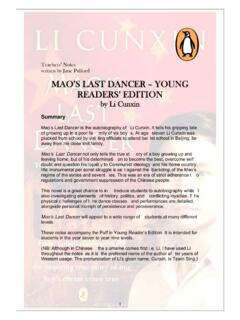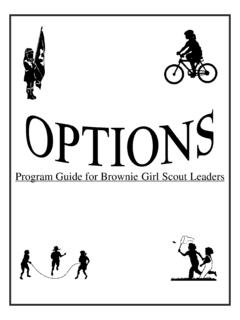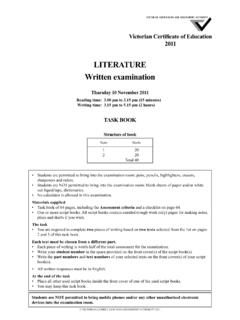Transcription of TSK Absolutely True Diary - penguin.com.au
1 THE Absolutely true Diary OF A PART-TIME INDIAN SHERMAN ALEXIE TEACHING SUPPORT KIT by Kathleen Noone TEACHING SUPPORT KIT The Absolutely true Diary of a Part-time Indian 2 THE Absolutely true Diary OF A PART-TIME INDIAN Teaching Support Kit CONTENTS 1. Introduction 3 2. Notes on genre, structure and style 3 3. Pre-reading: background notes 4 4. Themes, motifs and symbols 4 5. Character analysis 10 6. Activities 12 These notes may be reproduced free of charge for use and study within schools but they may not be reproduced (either in whole or in part) and offered for commercial sale.
2 Visit for information on other Random House Australia teaching support kits and reading guides. Copyright Random House Australia 2010 TEACHING SUPPORT KIT The Absolutely true Diary of a Part-time Indian 31. INTRODUCTION When Junior throws his geometry book at his teacher, little does he know the chain of events that are to follow. On Mr P s advice he decides to leave the Spokane reservation and its problems with poverty, domestic violence and alcoholism, and find the school with the most hope; the rich, white school in Reardan. In between telling his best friend Rowdy (and being punched hard in the face for his troubles), Junior must avoid the ire of the community and somehow find a way to travel twenty-two miles each day.
3 That s even before he gets to the school and faces isolation, racist taunts, insensitive teachers and the small issue of how to get back home again. Junior is an incredibly likeable character and you cannot help but be drawn into his world, cheering him on and admiring his tenacious spirit. He develop friendships with the most unlikely people and eventually realises that being a Spokane Indian does not mean he cannot be part of other tribes as well. The Absolutely true Diary of a Part-Time Indian is a very enjoyable and authentic coming-of-age story. The fresh and engaging writing style, alongside the often irreverent humour make this a book that is sure to appeal to young people.
4 2. NOTES ON GENRE, STRUCTURE AND STYLE The Absolutely true Diary of a Part-time Indian is a coming-of-age story written in first person narrative from the perspective of fourteen-year-old Arnold Spirit Jr, better known as Junior. As the title suggests, the narrative has a confessional quality, as Junior reveals his feelings to the reader through the use of verbal and visual language. The style is humorous and often irreverent, as Junior is at times unflinchingly honest about his emotions and experiences. Though this may be uncomfortable for the reader at times, such as when Junior learns of his sister s death and is concerned because, Yep, I had a big erection when I learned of my sister s death (p.)
5 202), it is this quality that helps makes the voice of the protagonist so authentic. The ongoing action of the novel is combined with an exploration of Junior s emotions and feelings. Of note is the unique structure of the novel. Interspersed within the narrative are pictures; cartoons that Junior draws because words are too limited . (p. 5) It is an engaging and effective technique that could lead to interesting discussions about visual imagery in the classroom, particularly about how the cartoons assist the readers understanding of the text. The often irreverent and black humour expressed in the cartoons develops the character of Junior more than would be possible with text alone.
6 Further, the use of cartoons has a thematic link to the poverty experienced by Junior and his community. He draws because he want[s] the world to pay attention to [him] (p. 6) and he knows that drawing is the only way [he] can become rich and famous . (p. 6) Junior acknowledges that being rich and famous might be [his] only real chance to escape the reservation. (p. 6) Therefore, the visual imagery has an added poignancy to it, illustrating both Junior s emotions and feelings, alongside his desire to make something of his life. The chapters are quite short and the dialogue is snappy and realistic, creating an authentic voice for each of the characters. The protagonist is funny and surprisingly matter-of-fact about his life.
7 Though his story is often sad, he does not invite the reader to feel sympathy for him, instead forcing admiration for his undeniable spirit. TEACHING SUPPORT KIT The Absolutely true Diary of a Part-time Indian 43. PRE-READING: BACKGROUND NOTES As part of your class study of The Absolutely true Diary of a Part-time Indian, answer the following research questions using the internet and your school library. Who are the Spokane Indians? Where are they located? What is their history? What are their customs and traditions? Why were reservations set up in America? What was their goal? Has it been successful? What are some of the issues and problems facing Native Americans?
8 Where in America is the Spokane Indian reservation located? Make a copy of a map with the area highlighted. How big is the reservation? How many people live there? That s how we were taught to teach you. We were supposed to kill the Indian to save the child. (p. 35) What does Mr P. mean when he says this? Why were they encouraged to kill the Indian culture (p. 35)? What do Americans celebrate at Thanksgiving? What is the Bureau of Indian Affairs? What is the Spokane Powwow? How can the plight of the Native Americans be compared with the journey of the Indigenous Australians? How are their experiences similar? How do they differ? 4. THEMES, MOTIFS AND SYMBOLS THEMES Identity and self-esteem I am zero on the rez.
9 And if you subtract zero from zero, you still have zero. (p. 16) There s probably no place more isolated than my reservation, which is located approximately one million miles north of Important and two billion miles west of Happy. (p. 30) I want you to say that you deserve better. I couldn t say it. It wasn t true . I mean, I wanted to have it better, but I didn t deserve it. (pp. 40 1) He was the loser Indian father of a loser Indian son living in a world built for winners. (p. 55) Reardan was the opposite of the rez. It was the opposite of my family. It was the opposite of me. I didn t deserve to be there. I knew it; all of those kids knew it.
10 Indians don t deserve shit. (p. 56) .. I woke up on the reservation as an Indian, and somewhere on the road to Reardan, I became something less than Indian. And once I arrived at Reardan, I became something less than less than less than Indian. (p. 83) I was half Indian in one place and half white in the other. It was like being Indian was my job, but it was only a part-time job. (p. 118) Well, life is a constant struggle between being an individual and being a member of the community. (p. 132) Junior finds it difficult to feel optimistic about himself and his culture during the novel. His poor self-esteem is connected with the idea of being poor and even believing that he deserves to be poor.










